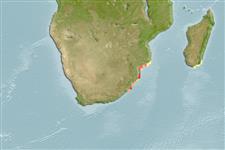Classification / Names
Nomi Comuni | Sinonimi | Catalog of Fishes(Genere, Specie) | ITIS | CoL | WoRMS | Cloffa
>
Blenniiformes (Blennies) >
Tripterygiidae (Triplefin blennies) > Tripterygiinae
Etymology: Enneapterygius: Greek, ennea = nine times + Greek, pterygion = little fin (Ref. 45335); kosiensis: Named after Kosi Bay, the area off which specimens were first found (Ref. 57774).
Environment: milieu / climate zone / depth range / distribution range
Ecologia
marino associati a barriera corallina; distribuzione batimetrica 1 - 30 m (Ref. 57774). Tropical
Distribuzione
Stati | Aree FAO | Ecosystems | Presenze | Point map | Introduzioni | Faunafri
Western Indian Ocean: currently known only from northern KwaZulu-Natal, South Africa.
Size / Peso / Age
Maturity: Lm ? range ? - ? cm
Max length : 1.9 cm SL maschio/sesso non determinato; (Ref. 57774)
Short description
Morfologia | Morfometria
Spine dorsali (totale): 15; Raggi dorsali molli (totale): 9; Spine anali 1; Raggi anali molli: 16 - 17. Dorsal fins III+XII+9; anal fin I,16-17 (usually 17 rays); pectoral fins 13, all rays simple; lateral
line with 12 pored scales and 21-22 notched scales, notched segment starting second scale row below end of pored segment, overlapping by one scale. Total lateral scales 32; transverse scales 1/4. Vertebrae 10+22. Mandibular pores 2+1/2+2. Head 3.2-3.5, body depth 5.1-5.3 in SL; eye 3.1-3.7 in head length; maxilla 2.6-2.9 in head length. Small fish, less than 20 mm SL. Body slender; scales large; nape scaled; belly with smaller, thin cycloid scales. Pelvic fins slender, rays united by a thin, fragile membrane for about one third length of shorter ray. First dorsal fin slightly higher than second, second 75-90% of body depth. Longest pectoral-fin ray reaches nearly to base of first ray of third dorsal fin. Supratemporal sensory
canal crescent-shaped. Mouth oblique, reaching vertical through anterior margin of pupil; interorbital concave and broad, about equal to pupil diameter; orbital cirrus a simple rounded flap and about half pupil diameter in length (Ref. 57774).
Collected from a flat reef (Ref. 57774). Female members of the Tripterygiidae have eggs that are hemispherical and covered with numerous sticky threads that anchor them in the algae on the nesting sites (Ref. 240). Larvae are planktonic which occur primarily in shallow, nearshore waters (Ref. 94114).
Life cycle and mating behavior
Maturità | Riproduzione | Deposizione | Uova | Fecundity | Larve
Holleman, W., 2005. A review of the triplefin fish genus Enneapterygius (Blennioidei: Tripterygidae) in the western Indian Ocean, with descriptions of four new species. Smithiana, Bull. 5:1-25. (Ref. 57774)
IUCN Red List Status (Ref. 130435)
Threat to humans
Harmless
Human uses
Informazioni ulteriori
Nomi ComuniSinonimiMetabolismoPredatoriEcotossicologiaRiproduzioneMaturitàDeposizioneSpawning aggregationFecundityUovaEgg development
Age/SizeAccrescimentoLength-weightLength-lengthLength-frequenciesMorfometriaMorfologiaLarveDinamica popolazioni larvaliReclutamentoAbbondanzaBRUVS
BibliografiaAcquacolturaProfilo di acquacolturaVarietàGeneticaElectrophoresesEreditarietàMalattieElaborazioneNutrientsMass conversion
CollaboratoriImmaginiStamps, Coins Misc.SuoniCiguateraVelocitàModalità di nuotoArea branchialeOtolithsCervelliVista
Strumenti
Special reports
Download XML
Fonti Internet
Estimates based on models
Preferred temperature (Ref.
123201): 23.6 - 25.4, mean 24.9 °C (based on 40 cells).
Phylogenetic diversity index (Ref.
82804): PD
50 = 0.5000 [Uniqueness, from 0.5 = low to 2.0 = high].
Bayesian length-weight: a=0.01000 (0.00244 - 0.04107), b=3.04 (2.81 - 3.27), in cm total length, based on all LWR estimates for this body shape (Ref.
93245).
Trophic level (Ref.
69278): 3.0 ±0.3 se; based on size and trophs of closest relatives
Resilienza (Ref.
120179): Alto, tempo minimo di raddoppiamento della popolazione meno di 15 mesi (Preliminary K or Fecundity.).
Fishing Vulnerability (Ref.
59153): Low vulnerability (10 of 100).
